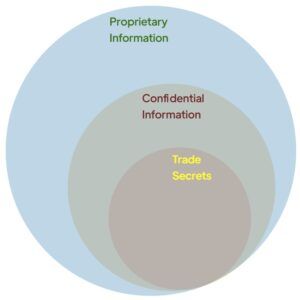Content Highlights
Trade secrets and confidential information are not the same thing. Treating them the same would be like treating the Coke a Cola recipe the same as Coke’s upcoming business plan. Read on to learn what the differences are and why they matter.
At Gardner Employment Law, we have years of experience dealing with all manner of trade secrets cases. If you want to know more about trade secrets and confidential information, feel free to reach out to us.

What Is Proprietary Information?
Proprietary information is all of the unique information a business creates. This first umbrella encompasses a huge amount of information, including confidential information and trade secrets. However, confidential information and trade secrets are both smaller subsets of proprietary information, which is information developed by a company that relates to or is associated with the company’s products, business, or activities.
Generally, proprietary information which is not “confidential” or does not constitute a “trade secret” is not protected. Despite its lack of protection, understanding the meaning of the term “proprietary information” is important since sometimes these three terms are incorrectly used interchangeably. Proprietary information is just the overarching term used to classify all information unique to a business.
The key distinction between proprietary information, on the one hand, and confidential information and trade secrets, on the other hand, is what is known to the public. Proprietary information includes information that is unique to a business, but also may be known to the general public. Confidential information and trade secrets are not known to the public and are governed by different statutes and definitions.
What is Confidential Information?
Confidential information is information unique to a business, but is not generally known by the public. It is information that employees learned while employed that they could not learn outside the four walls of their company. Confidential information is a subset of proprietary information and is subject to protections. We covered confidential information in-depth in our blog post “The Legal Meaning of Confidential Information”.
Unlike trade secrets, confidential information does not have a precise definition. That is the reason why most employment agreements contain a definition of confidential information. Understanding what is and is not confidential information for your specific situation is important for protecting yourself or your business. An employee must be careful not to reveal confidential information which he or she learns at work, outside of need-to-know persons, or else they may find themselves in court. Our firm was once involved in a four-week trial over business cards that a group of employees took with them when they left and went to work for a competitor.
Whenever confidential information is discussed, it is important to talk about NDA’s (non-disclosure agreements) as well. An NDA is a contract between two parties which stipulates that certain confidential information will not be disclosed to outside parties. A contract is not required to protect confidential information. The common law that has been in place for decades holds that an employee leaving the company is prohibited from using or disclosing the employer’s confidential information. However, having a contract in place sets the stage for recovery of damages in court if the contract is breached and thus provides greater protection because of its deterrence value. Even if you do not sign an NDA or an employment agreement detailing confidential information, Texas law still prohibits the use or disclosure of confidential information learned while on the job.
Examples of confidential information include research data, business plans, marketing campaigns, and other information which is not generally known to the public. It includes customer lists. It even includes facts such as the purchasing manager’s favorite place to sit at a particular restaurant (a real case). These are all things which are important to a business which revealing to a competitor could cause harm, even though the information itself does not possess any independent economic value. The lack of independent value is one of the key distinctions between confidential information and a trade secret.
What is a Trade Secret?
Trade secrets are defined by statute, and the primary factor is that they have economic value. All trade secrets are confidential information, but not all confidential information is a trade secret. The Texas Legislature passed the Texas Uniform Trade Secrets Act to protect and define trade secrets. Under the Act a trade secret is defined as:
“Trade secret” means all forms and types of information, including business, scientific, technical, economic, or engineering information, and any formula, design, prototype, pattern, plan, compilation, program device, program, code, device, method, technique, process, procedure, financial data, or list of actual or potential customers or suppliers, whether tangible or intangible and whether or how stored, compiled, or memorialized physically, electronically, graphically, photographically, or in writing if:
(A) the owner of the trade secret has taken reasonable measures under the circumstances to keep the information secret; and
(B) the information derives independent economic value, actual or potential, from not being generally known to, and not being readily ascertainable through proper means by, another person who can obtain economic value from the disclosure or use of the information.
Trade secrets are usually highly valuable to a business and integral in their operation. Coke a Cola’s secret recipe is a notable example of a trade secret. Whether or not you side with Pepsi or Coke, everyone knows how important and valuable Coke’s secret recipe is. However, there are many examples of trade secrets which are not as noteworthy as Coke’s secret recipe.
In 2019, the New York Times wrote an article about a Google engineer who took trade secrets from Google’s autonomous vehicles division and went to work for Uber shortly after Uber purchased its own autonomous driving division. In this case, the trade secrets taken included thousands of highly sensitive files on Google’s autonomous vehicles division. Uber hired the defendant to be in charge of its new autonomous vehicle business. Obviously, Google would want to maintain its edge in this line of business. If another company such as Uber obtained Google’s trade secrets, Google would lose that edge. The information at stake here was not merely unique to Google, nor was it simply confidential information. The information at stake was highly guarded and certainly had independent economic value to Google.
As shown in the diagram above, trade secrets are a smaller subset of confidential information, with confidential information being then a subset of proprietary information. It is important at each step of the way to treat each varying level of information differently. Trade secrets should be the most highly protected pieces of information in a business. Think about how highly protected Coke a Cola’s secret recipe is. The recipe has never been patented, never written down, and known only to a select few at the very top of the company. You wouldn’t keep your grandfather’s secret brisket recipe in the same drawer as your grocery list, and you shouldn’t treat your trade secrets the same as your confidential information.
Why Are These Distinctions Important?
Understanding the differences between proprietary information, confidential information, and trade secrets is essential to making sure your important information is protected from disclosure and that you have recourse if your protections are violated. Blurring the lines between these three categories can result in losing business, losing money, and potentially irreparable harm.

